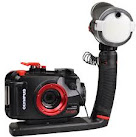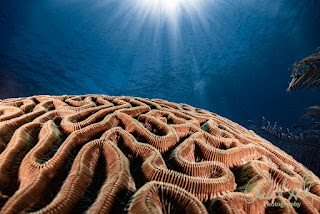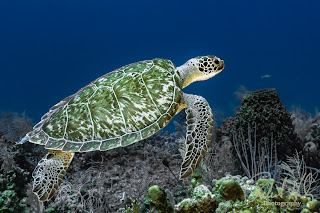Discover the Secrets of Flash Sync:
A Deep Dive into Techniques for Captivating Underwater Photography, Packed with Tips, Tricks, and Insider Knowledge!
Introduction: If you are interested in underwater photography, you might be familiar with the TTL (Through The Lens) technique. However, taking beautiful pictures of underwater life requires precision and technical skills, especially when it comes to using flash photography. It is important to understand the various flash sync options available in modern cameras to achieve the best outcomes. In this blog, I will explain the different types of flash sync and their applications, with a focus on what would be most beneficial for underwater photographers in both wide-angle and macro scenarios.
Types of Flash Sync:
- Front-Curtain
Sync:
- How
it works: Front-curtain sync fires the flash at the beginning of the
exposure, freezing the motion of the subject at the start of the shutter
opening.
- Result:
This is the default setting for most cameras. It's suitable for general
photography but may cause issues in certain situations, such as creating
a distracting motion blur in fast-moving subjects.
- Rear-Curtain
Sync:
- How
it works: Rear-curtain sync fires the flash at the end of the
exposure, allowing any motion blur to precede the frozen flash-lit
subject.
- Result:
Ideal for capturing movement with a sense of motion, making it a popular
choice for nighttime photography or when you want to emphasize the trail
of a moving object.
- High-Speed
Sync (HSS):
- How
it works: High-Speed Sync allows for flash firing at shutter speeds
faster than the camera's maximum sync speed, by pulsing the flash
multiple times during the exposure.
- Result:
Effective for outdoor shoots with wide apertures in bright conditions,
but may reduce the flash's power output and battery life.
- Slow
Sync:
- How
it works: Slow sync combines a longer shutter speed with flash to
capture ambient light while illuminating the subject.
- Result:
Ideal for low-light conditions, creating a balanced exposure between the
foreground (illuminated by the flash) and background (captured with
ambient light).
Underwater Flash Sync for Wide-Angle Photography:
For wide-angle underwater photography, where capturing the
vast expanse of the ocean is key, a combination of slow sync and rear-curtain
sync is often beneficial. This allows the ambient light to contribute to the
overall scene, while the rear-curtain sync freezes the subject at the end of
the exposure, ensuring a sharp and well-lit foreground against the softly
illuminated background.
Underwater Flash Sync for Macro Photography:
Macro photography underwater demands a different approach.
Front-curtain sync is commonly preferred, ensuring the flash freezes the tiny,
intricate details of marine life at the beginning of the exposure. The quick
burst of light enhances the subject, making it stand out against the often
cluttered and intricate background. Additionally, using HSS may be advantageous
when shooting macro subjects in bright, shallow waters, allowing for higher
shutter speeds without sacrificing flash synchronization.
Conclusion: If you're into taking pictures underwater, you might have noticed that it can be tricky to get that perfect shot. One important thing to know is how to properly sync your flash with your camera. There are different ways to do this depending on the lighting conditions and the type of photo you want to take. By learning about these techniques and using them in the right way, you can take amazing pictures of the underwater world that will truly bring it to life in your photos.
Fine-Tuning Your Underwater Flash Photography: Tips and
Tricks
Introduction: Let's talk about some useful tips and tricks that can help you take stunning underwater photos. Whether you're looking to capture the beauty of vast underwater landscapes or the tiny details of sea creatures up close, these insights will help you overcome the challenges of shooting in water. I'll cover everything you need to know to elevate your underwater photography game and take amazing shots.
**1. Understanding Water Conditions:
- Tip:
Water absorbs and scatters light differently than air. Consider factors
such as visibility, watercolor, and depth when setting up your flash
sync. Adjust flash power and settings accordingly to compensate for
potential loss of color and contrast.
**2. Positioning of the Flash:
- Tip:
Experiment with different flash positions to avoid backscatter, the
unwanted reflection of light off suspended particles in the water.
Positioning the flash slightly off to the side or above the camera using extension arms can
help minimize these reflections and enhance the clarity of your shots.
**3. Color Temperature Considerations:
- Tip:
Underwater environments can introduce a blue or green color cast to your
images. Use color correction filters or adjust the white balance settings
on your camera to maintain accurate and vibrant colors. If shooting RAW format, you can also make these adjustments in Post-Processing.
**4. Mastering Manual Flash Control:
- Tip:
While automatic flash settings can be convenient, manual control allows
for precise adjustments. Familiarize yourself with your flash unit's power
settings and learn to adapt them based on the subject's distance and
desired exposure.
**5. Mixing Natural Light and Flash:
- Tip:
Strive for a balance between ambient light and flash illumination,
especially in wide-angle shots. Adjust your shutter speed and aperture to
capture the ambient light, and use the flash to highlight the main
subject.
**6. Macro Photography Techniques:
- Tip:
When shooting macro subjects, get close and use a narrow aperture to
achieve a greater depth of field. Front-curtain sync is often the go-to
choice to freeze the subject's movement while maintaining a well-lit
foreground.
**7. Wide-Angle Composition Strategies:
- Tip:
Focus on composition to tell a compelling underwater story. Utilize the
play of light and shadow to create depth, and consider incorporating
interesting foreground elements to enhance the overall visual appeal.
Conclusion: In the world of photography, capturing the perfect shot underwater can be a challenging task. But don't worry, with the right techniques and a little bit of creativity, you too can capture the stunning beauty that lies beneath the surface.
To get started, it's important to consider the water conditions, such as clarity and lighting, and to use the right color balance to ensure that your photos look natural.
Mastering the use of underwater flashes can also be very helpful in achieving beautiful and well-lit photos. It takes some technical expertise, but with practice and patience, you can learn how to use them effectively.
With a combination of technical skills and creative intuition, you'll be able to capture breathtaking photos of all the amazing creatures and landscapes that the ocean has to offer. So, don't be afraid to dive in and explore - the ocean is waiting for you and your camera!
Stay tuned and "Follow" for upcoming blogs on underwater photography tips and tricks for more in-depth insights. Please leave your comments and suggestions. Enjoy your diving and shooting experience!
I am eagerly anticipating your valuable feedback and suggestions.
Sincerely,
Bob Herb
|
|






Comments
Post a Comment
Please let me know your comments.